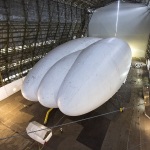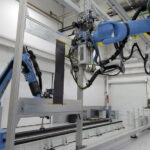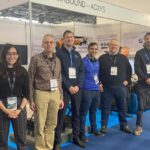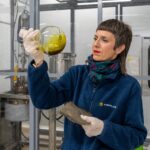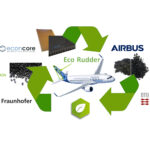It’s been nearly ten years since we first heard rumors about the Airlander 10. But finally, after a number of stops and starts and $35.6 million, British aerospace company Hybrid Air Vehicles (HAV) unveiled an airship prototype that is so large, the Guinness Book of World Records is reportedly on its way to Cardington at Bedfordshire, north of London, to give its stamp of approval. At a length of 302 feet (92 meters)—that’s 62 feet longer than an Airbus A380—and with a cargo capacity of 10 metric tons, this thing is huge. It is currently occupying the largest hangar in the U.K., where it’s floating a few feet in the air, straining against the cables tying it down, as if eager to take flight. And it will—soon. Any day now, the hybrid aircraft is expected to begin its 200 hours of required test flights, before it can be offered to prospective customers.
It’s being called a “hybrid,” as it combines components of fixed-wing aircraft, helicopters, and airship technology. The main element, however—what keeps it afloat and gives it its…posterior-shaped curvature—is the lighter-than-air helium that will fill the carbon fiber hull. For airship innovators, inert helium—which is not flammable—has long replaced the combustible hydrogen that caused the Hindenburg to turn into a ball of fire in 1937.
In the Airlander 10’s case, the cockpit is not all that dissimilar from a jumbo jet, but with a few added buttons and switches that control different helium-filled compartments for lift, hovering, and landing. The aircraft is eco-friendly, silent, and due to its pneumatic “skids,” is able to land on practically any terrain, including water, without the need of an airstrip. Besides going on trips that could last up to five days, it can also float, unmanned, for weeks at a time. While there are no confirmed buyers, HAV has hinted that various militaries have shown interest, presumably for use in surveillance and cargo. The project was originally funded by the U.S. military, which had to pull out due to budget cuts. But that’s when the British military stepped in, and it has since been one of the main investors of the project.
Beyond military use, the Airlander 10 is expected to be appealing to governments and businesses that need to deliver large amounts of cargo to remote locations, novelty tourists (the aircraft will fly at a low altitude and include floor-to-ceiling windows), and telecommunications companies. But the Airlander 10 is not built to compete with fixed-wing aircraft for large-scale transportation: The aircraft’s V8 engines will only allow it to reach a maximum speed of 91 mph—a far cry from the A380’s cruising speed of 560 mph.



